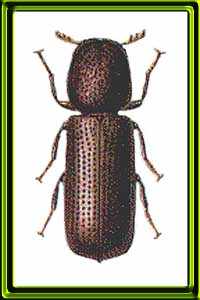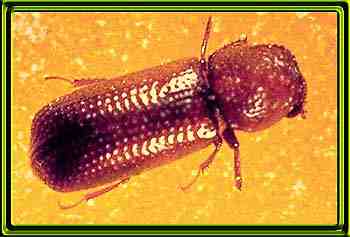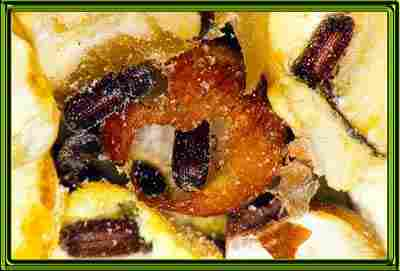
Rhyzopertha
dominica
(Lesser Grain Borer)
(Lesser Grain Borer)
This is one of the smallest of the grain-infesting beetles, but one of the most important. Originally native to the tropics, it has spread through commerce to all parts of the world. It is most prominent in the United States, southern Canada, Argentina, India, and Australia. In the United States, it is particularly widespread in the Gulf states. Both adults and larvae feed within the interiors of nearly all grains, including rice, and the kernels are reduced to mere shells, hence it is a hidden infestation until the adults are apparent.Description:
The adult is about 3 mm long, polished dark brown or black, and has a somewhat roughened surface. In common with other bostrichids, which are principally woodborers, Rhyzopertha dominica is almost cylindrical, and the head is vertically deflexed under the thorax so that it cannot be seen from above. Likewise, this insect, though small, has powerful jaws with which it can bore directly into wood . Wood may have been its original food. It can eat its way into wooden and paper boxes, and may destroy book bindings.
Photograph courtesy of Jim Kalisch University of Nebraska
Life Cycle:
The female lays 300 to 500 eggs, singly or in clusters, in the loose grain. They hatch in a few days. The larvae moult 2 to 4 times. They may feed on the flour produced by the boring of the adults, or may bore directly into kernels that have been slightly damaged. They complete their growth within the grain, transform to white pupae, and the adults cut their way out. The life cycle takes only a month or two, depending on the temperature. The adult lesser grain borers chews grain voraciously causing damage which may facilitate infestation by a secondary pest. It is a strong flyer and may rapidly migrate from infested grain to begin new infestations elsewhere.
Factors Favoring Stored Grain Insects:
Temperature is a crucial environmental factor that influences the development of insects. There is always a minimum, optimum and a maximum range of temperature in which insects can survive. The most favorable temperature for most stored grain insects is about 80°F. Above 95°F or below 60°F, reproduction and survival is greatly reduced. Insects differ in their tolerance to either low or high temperatures. Most stored product pests would follow the same pattern of survival under a different range of temperatures. As temperature approaches zero, insect development, activity and movement decline to a minimum. Gradual increase in temperature will increase insect activity up to a certain range that differs among different species. Further increase in temperature above the optimum range will lead to increase in insect mortality and crashing of the population.
The most favorable moisture range for stored grain insects is 12 to 15% (optimum 14 to 15%). The lowest moisture content for any survival and reproduction to occur is about nine percent. However, as temperature increases insects can reproduce in grain with a lower moisture content, and when moisture increases they can reproduce at lower temperatures. The life processes of the insects can increase the moisture content of "dry" grain.
Insect infestations are more likely in "dirty" grain than in clean grain. The presence of grain dust, cracked kernels, and dockage permits some grain insects to survive and reproduce at low moisture levels.
Photograph courtesy of Jim Kalisch University of Nebraska

